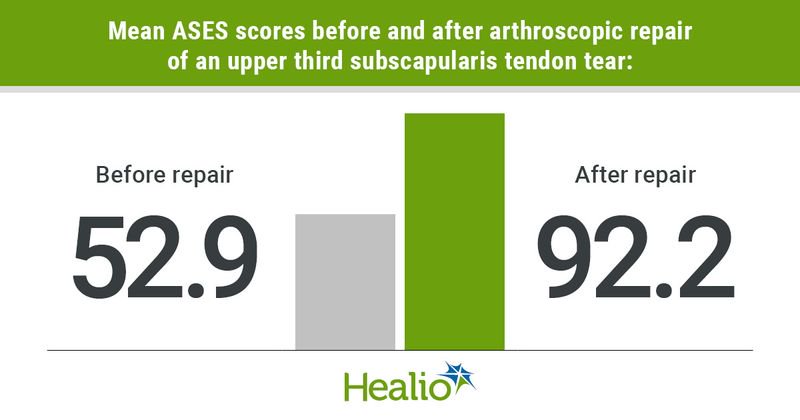Arthroscopic upper-third subscapularis tendon repair improved patient outcomes
Click Here to Manage Email Alerts
Key takeaways:
- Arthroscopic repair of an upper-third subscapularis tendon tear improved patient-reported outcomes at minimum follow-up of 10 years.
- Patients reported a median 10 out of 10 satisfaction score.
Patients who underwent arthroscopic repair of an upper-third subscapularis tendon tear had improved clinical outcomes and satisfaction at minimum 10-year follow-up, according to published results.
Rony-Orijit Dey Hazra, MD, and colleagues at the Steadman Philippon Research Institute analyzed outcomes of 14 patients (mean age of 52.7 years) who underwent isolated arthroscopic upper-third subscapularis tendon repair between November 2005 and August 2011. According to the study, outcomes were prospectively collected and retrospectively reviewed at a minimum follow-up of 10 years. Outcomes included American Shoulder and Elbow Surgeons scores, single assessment numeric evaluation (SANE) scores, QuickDASH scores, SF-12 physical component summary (PCS) scores, return to activity and patient satisfaction.

Overall, follow-up was obtained for 11 patients. Mean ASES score improved from 52.9 to 92.2 after surgery. Mean postoperative SANE, QuickDASH and SF-12 PCS scores were 90.27, 14.6 and 49.2, respectively. Researchers found median patient satisfaction was 10 out of 10. They also noted patients reported improvements in sleep, activities of daily living and sport.
“The most important findings of this study are the excellent subjective functional outcomes, high [patient-reported outcomes], high patient satisfaction and a 100% survivorship rate at minimum 10-year follow-up after arthroscopic [subscapularis] repair utilizing one-anchor,” researchers wrote in the study. “As the [subscapularis] is involved in numerous complex movements of daily life, such as putting on a coat, washing the back, fastening a bra and managing the toilet, restoring function to this muscle can have a substantial impact on patients’ quality of life,” they concluded.

